The diaries of Gabriele Rabel
In preparation for the conference ‘Keeping and Making Diaries’ the archives team have been taking a closer look at some of the diaries in our collections. Gabriele Rabel (1880-1963) kept diaries from the age of 13, when she was first given a diary for her birthday. Her archive contains 35 files of diaries and memoirs – some handwritten and some typed, some in German and some in English. I was interested to find out more.
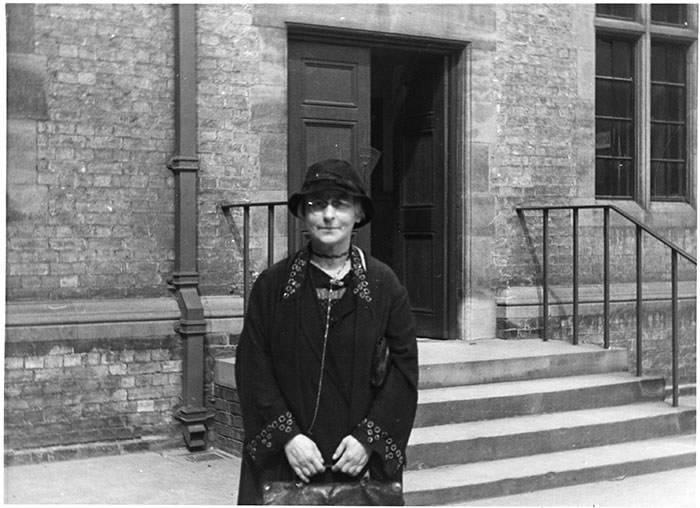
Photo of Gabriele Rabel in 1938, from the Smithsonian Archives
Gabriele Rabel was born into a wealthy family in Vienna in 1880. She studied biology under Professor Richard Wettstein at the University of Vienna, and then did experimental work on the colour adaptation of certain plants to their surroundings. Rabel developed an interest in theoretical physics and became a pupil of Des Coudres in Leipzig as well as Max Planck and Albert Einstein in Berlin. She received her doctorate in physics.
In 1923, Rabel became seriously ill, was diagnosed as suffering from manic depression and spent two years in a sanatorium. She became interested in philosophy and was involved with Rudolph Steiner and Count Hermann Keyserling. She published numerous articles in newspapers and journals.
Next Rabel turned to philological research, working in the Goethe Archives in Weimar and in 1927 she published a book on Goethe and Kant. That same year she left on a lecture tour of the United States where she remained for four years giving lectures on Austrian history and culture and a wide range of philosophical and general topics.
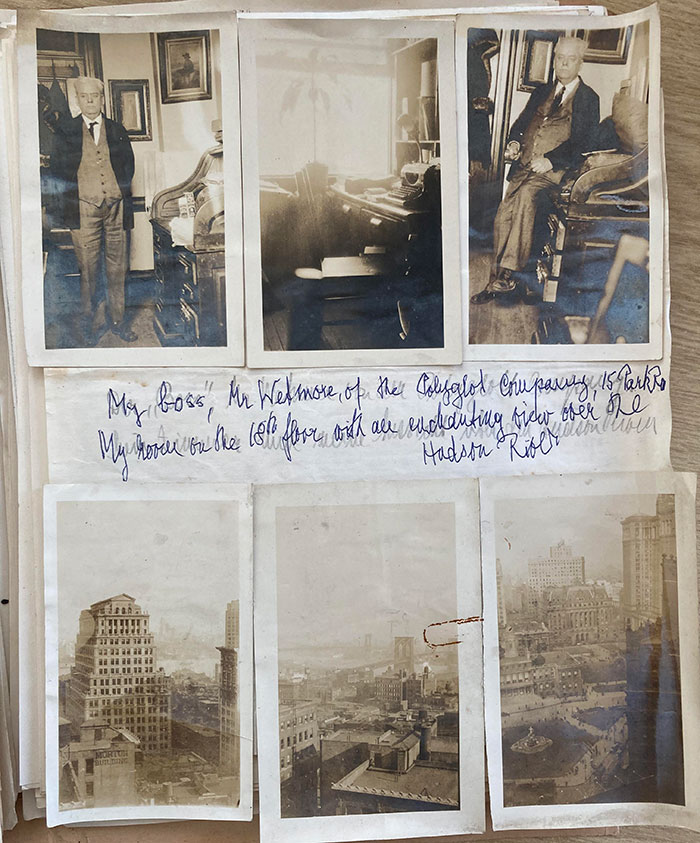
Photographs taken by Rabel during her lecture tour of the United States. Included in her typed memoirs about America. RABL 2/30
Rabel moved to Cambridge before the start of the Second World War, and wrote articles for scientific journals on evolution and genetics amongst other subjects. Rabel had become a friend of the physicist Otto Frisch and a number of other scientific members of the University. She lived in the Cambridge area to be over 80.
Formats of diaries
The collection at Churchill Archives Centre contains:
- 24 original handwritten diaries in German. Many of these have had the covers removed, and some are labelled with volume numbers (volumes 10-55 with many volumes missing).
These handwritten diaries cover (incompletely) Jul 1905-Jul 1933. This is also not a complete set of diaries, which Rabel estimated to number over 80 or too many to count.Some of these handwritten German diaries have typed summaries in English.
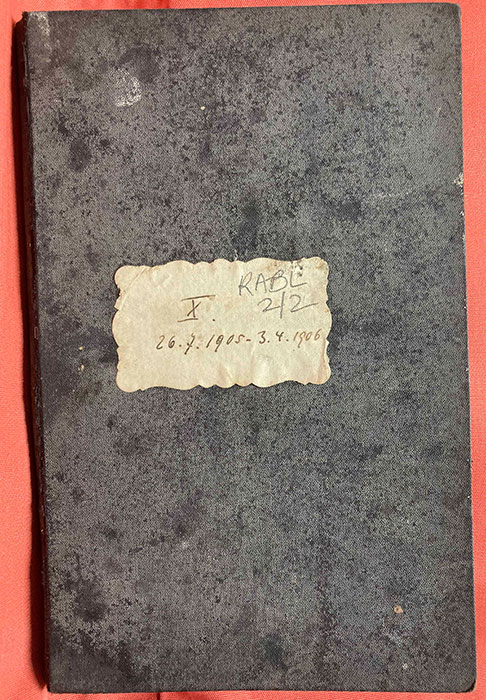
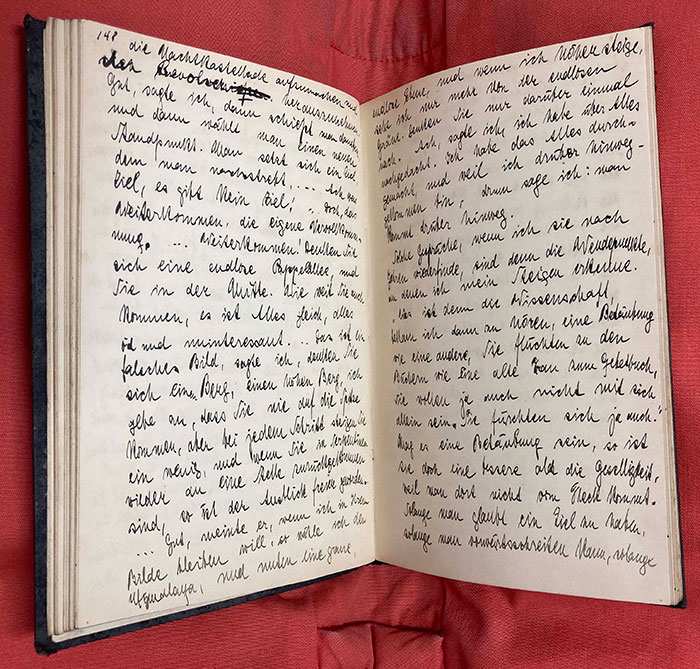
Gabriele Rabel’s diary, covering 26 July 1905 to 3 April 1906, written in Vienna. Labelled as volume 10. One of the few diaries to still have its cover. Reference RABL 2/2
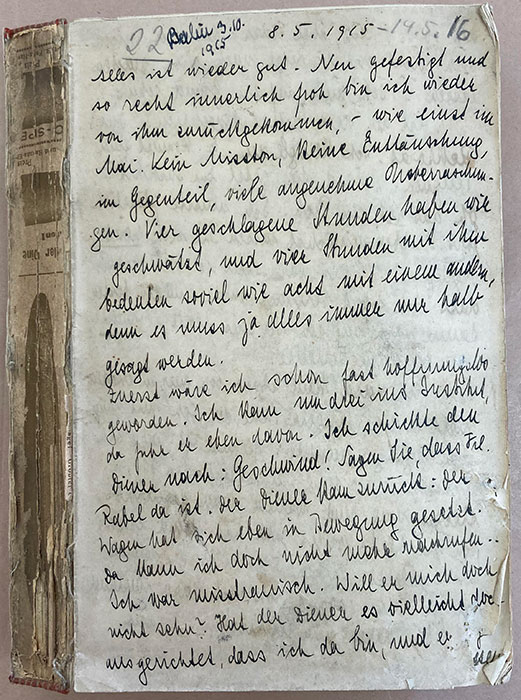
Rabel’s handwritten diary covering 8 May 1915 to 14 May 1916, written in Berlin. The cover has been removed and the volume is labelled as number 22. Reference RABL 2/14/1
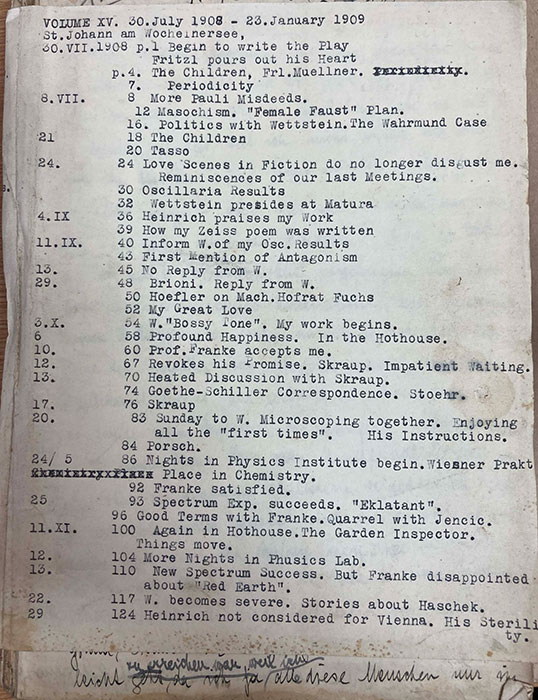
Part of an English summary wrapped around an original handwritten German diary, Reference RABL 2/4
2. Typed diary extracts in German, covering May 1906-Jan 1910 and Oct 1913-Oct 1915. These seem to be typed extracts from the original handwritten diaries, and some are noted as having been typed up in 1948-1949. (4 files)
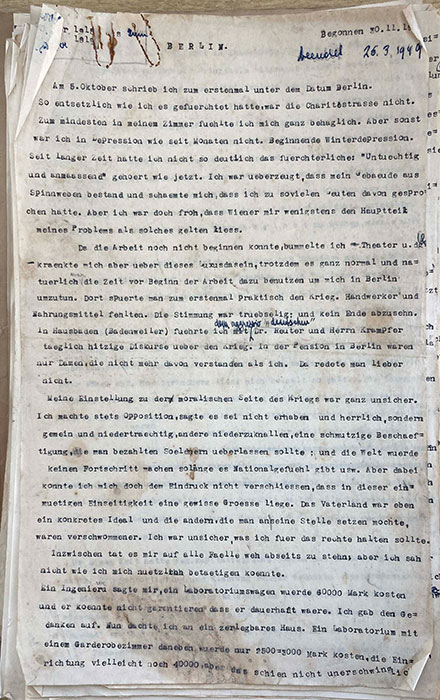
Typed diary in German, covering Oct 1915-Oct 1919, but typed up from 30 Nov 1948-26 Mar 1949. Ref: RABL 2/13
3. A German typed memoir and diary extracts written in Vienna after Rabel had heard of Dr Heinrich’s death (who had treated Rabel during her breakdown in March 1923). Diary extracts cover March 1923 to the middle-end of the 1920s. With an introduction in English, written in Cherry Hinton, Cambridge, 1 Apr 1960. (1 file)
4. Typed extracts from early diaries 1893-1903 (written when Rabel was aged 13 to 23), translated into English. (1 file)
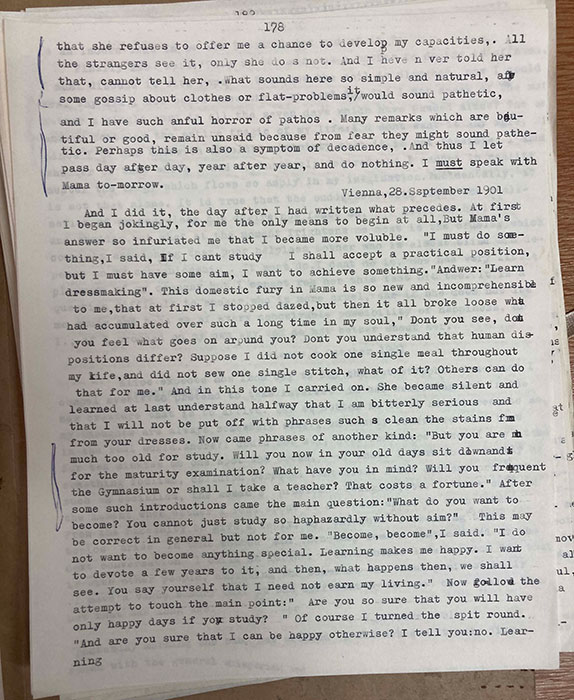
Translated extract of Rabel’s diary attesting to her struggles against her parents expectations, as she wanted to study or have an occupation. Reference: RABL 2/1
5. Typed memoirs in English:
- ‘The Bridge’ (about a scientific society), Jun 1911-Sep 1912, with additional notes from 1959 (1 file)
- ‘My Intercourse with the Count Herman Keyserling and Dr Rudolf Steiner (1921-1923)’ which includes diary entries, and an epilogue written in 1960
- ‘America I, also including the fate of “Goethe and Kant”’ and ‘America II’. 22 Jan 1927-12 Aug 1930
- ‘My Intercourse with Wettstein from 21 January 1927 to his death in 1931’. Typed diary entries from 21 Jan 1927-22 June 1929
6. Typed diary entries translated into English, 29 Oct 1913-1 May 1915 and 15-19 May 1920 (2 files)
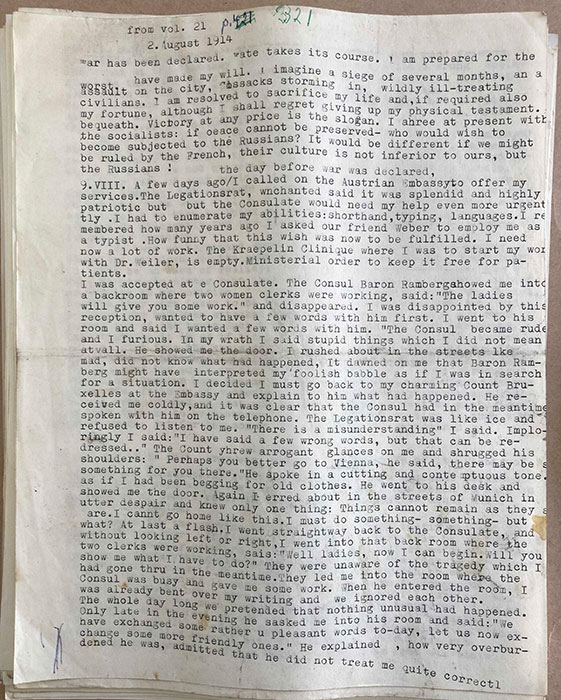
Translated diary extract for 2 Aug 1914 “War has been declared”. Reference: RABL 2/11
7. Draft memoir in English, written in 1958-1960 but reflecting on Rabel’s life, titled ‘My Life: Failures and Follies’
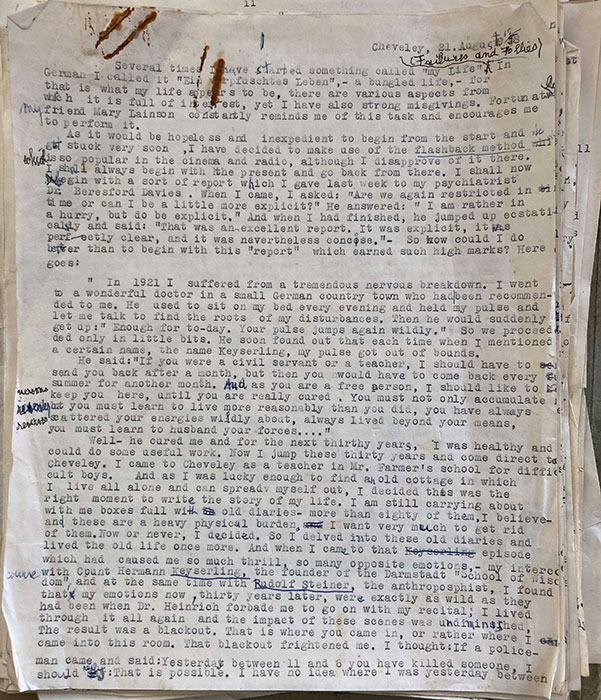
A draft page from ‘My Life: Failures and Follies’, 21 Aug 1958. Reference: RABL 2/34
So why the different formats? The key to understanding the diaries in the Rabel papers is the fact that Rabel was intending to publish them.
Rabel writes about her decision to preserve the diaries and publish them in draft introductions to ‘My Life: Failures and Follies’ (RABL 2/34)
Cheveley [Cambridgeshire], 23 Jul 1958
“The question what to do with my diaries, whether to burn or preserve them, was one which occupied my mind very much. I have finally decided to preserve them, with a view to possible publication at a later time for the following reason: Physicians know certainly much about my type of disease, especially in those violent stages which must be subjected to hospital treatment. The general public does not know much about it.”
Cheveley, 21 Aug 1958
“I came to Cheveley as a teacher in Mr Farmer’s school for difficult boys. And as I was lucky enough to find an old cottage in which I live all alone and can spread myself out, I decided this was the right moment to write the story of my life. I am still carrying about with me boxes full with old diaries – more than eighty of them, I believe – and these are a heavy physical burden. I want very much to get rid of them. Now or never, I decided. So I delved into these old diaries and lived the old life once more.”
Rabel wrote again about her decision to publish her diaries, and to begin with specific portions, in her introduction to ‘My intercourse with Count Herman Keyserling and Dr Rudolf Steiner (1921-1923)’, written c. 1960 (RABL 2/24)
“For a long time past I have toyed with the idea that my diaries which cover the period from my teenage to my old age and fill so many volumes that I was never able to count them, should be published two hundred years after my death. I know that 200 years after death even a laundry slip gains literary importance – even if it belonged to a person who did not acquire fame during their lifetime.
Recently I have decided to skip the 200 years and begin the publication of two portions of my diaries even now. These portions are the most likely to attract attention and bring in money, because they contain a lot of private gossip and their publication is probably pretty vulgar.”
Despite Gabriele Rabel’s efforts, her diaries and memoirs remain unpublished. Perhaps they are calling out to be revisited?
Madelin Evans, Archivist
